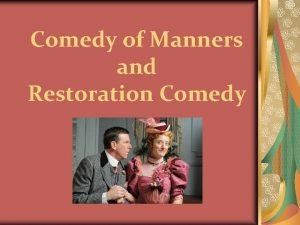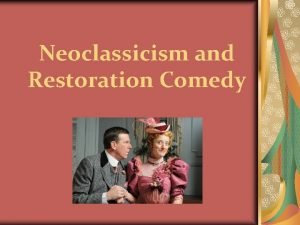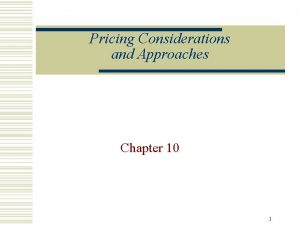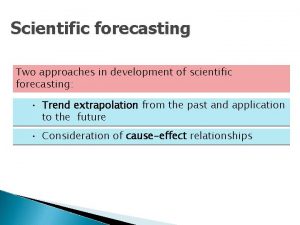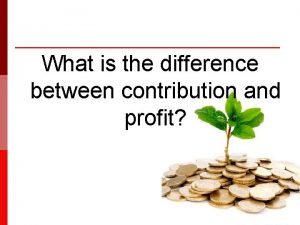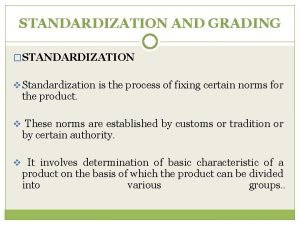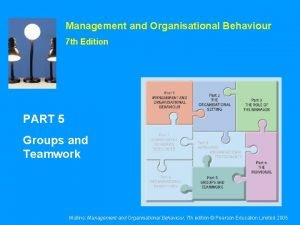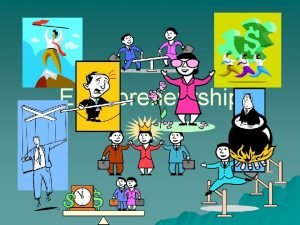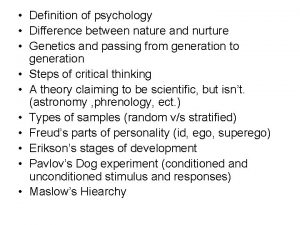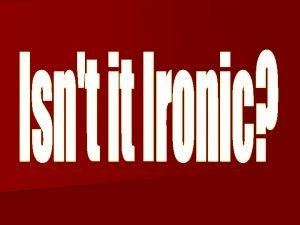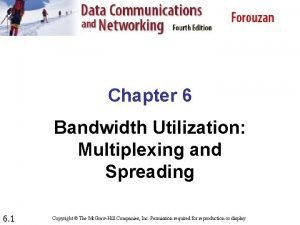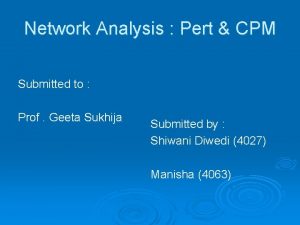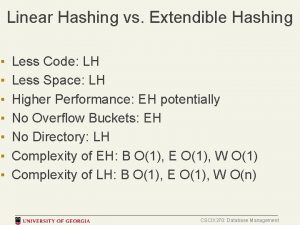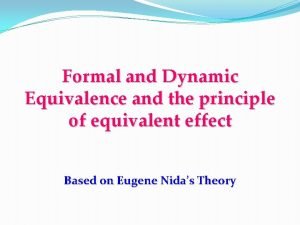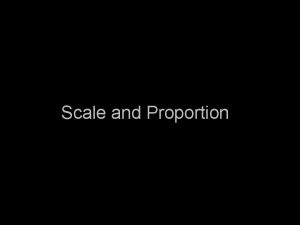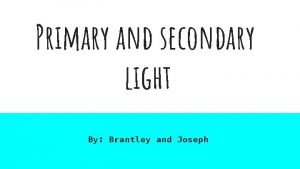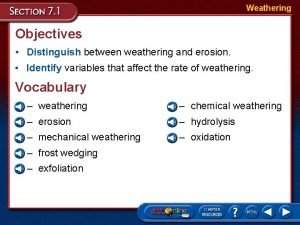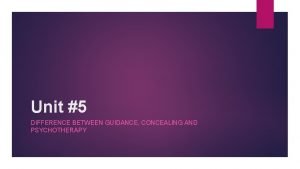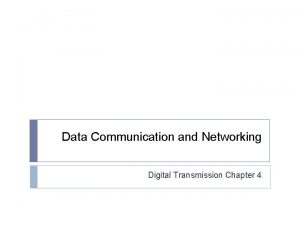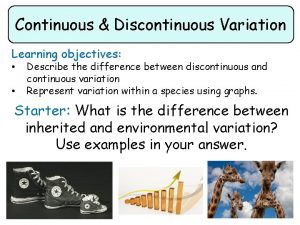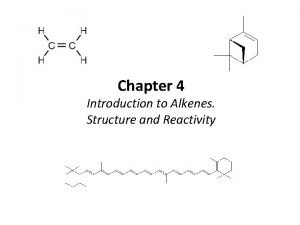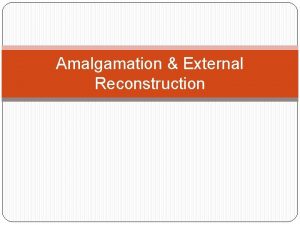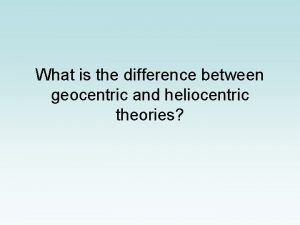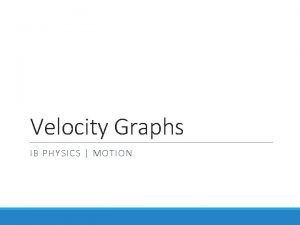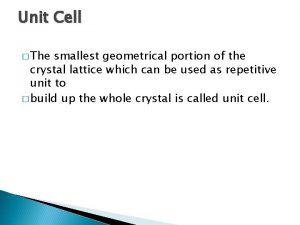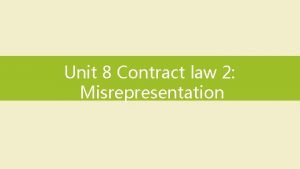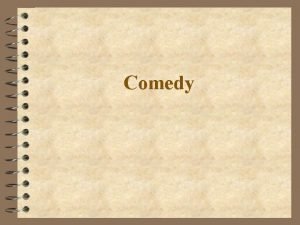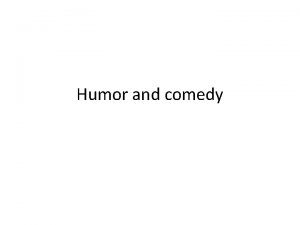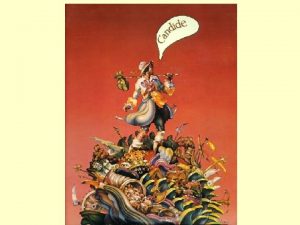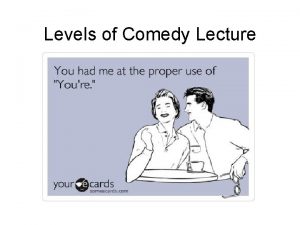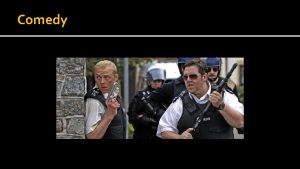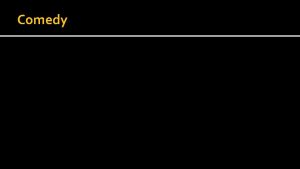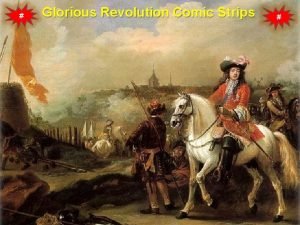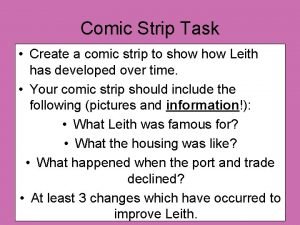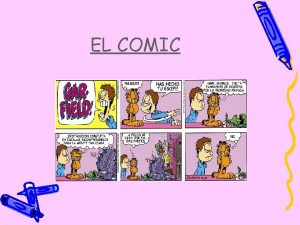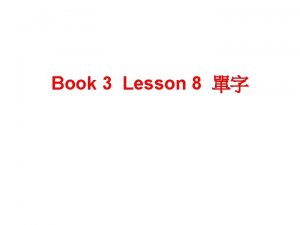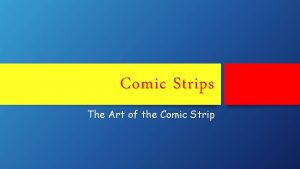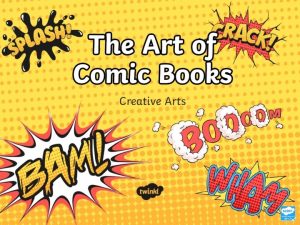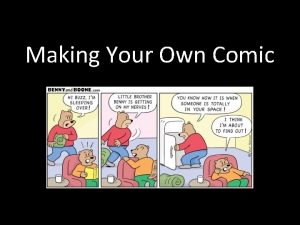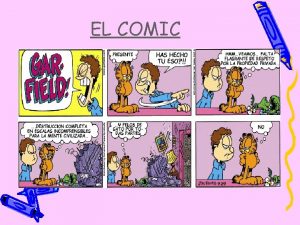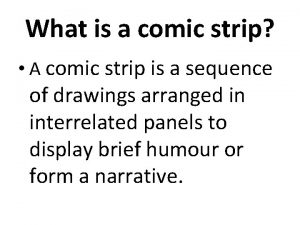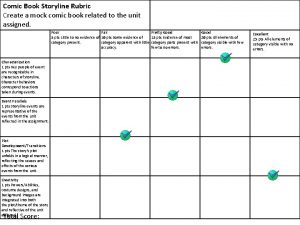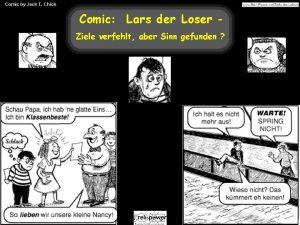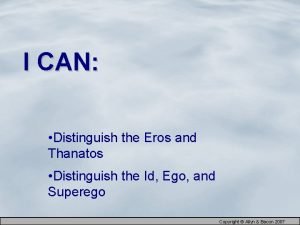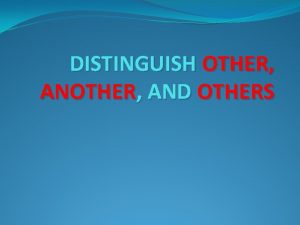Comedy General Approaches Distinguish comedy the comic and





















































- Slides: 53

Comedy: General Approaches • Distinguish comedy, the comic, and humor • Comparisons with tragedy – form – purpose – subject – outcomes • Alternatives to the tragedy/comedy divide


General Definition (Abrams) • “In the most common literary application, a comedy is a fictional work in which the materials are selected and managed primarily in order to interest and amuse us: the characters and their discomfitures engage our pleasurable attention rather than our profound concern, we are made to feel confident that no great disaster will occur, and usually the action turns out happily for the chief characters. ”

Limits • Abrams limits the term comedy to performing arts, including film. • The comic has a more general literary application, which I will summarize through Stott. • Other idiomatic uses are possible.

Abrams’s (Dramatic) Types • Romantic comedy (Elizabethan origins) • Satiric comedy (Old Comedy/Greek origins) • Comedy of manners (New Comedy/Greek origins) – Restoration comedy (1660 -1700) • Farce (burlesque, vaudeville) • High comedy (black comedy, cf. low comedy)

Ancient Comic Playwrights • • Aristophanes (Greek dramatist) Menander (Greek dramatist—fragments) Terence (Roman dramatist) Plautus (Roman dramatist)

Status (Stott) • No trustworthy extant treatises on comedy in the ancient world • Lack of authorities affects status

Dismissal of Comedy (Stott) • “Comedy is often perceived as ephemeral and lacking intellectual weight, or…is seen as an aspect of communication that is emphatically closed to study and interrogation. While there a number of reasons for the cultural second-place that comedy occupies, the most forceful among them are a product of concepts relating to the nature of literature, the proper objects for intellectual enquiry, and rejection of supposedly ‘popular’ forms in favour of elite ones. ”

Function (Stott) • Understood in reference to (as well as subordinate to) tragedy • The comic (note distinction) generally disparaged in ancient philosophers as contrary to reason • Justified as “corrective” (e. g. Ben Jonson, William Congreve—but of Greek origin)

From Aristotle’s Poetics • “Comedy is (as we have said) an imitation of inferior people—not, however, with respect to every kind of defect: the laughable is a species of what is disgraceful. The laughable is an error or disgrace that does not involve pain or destruction: for example, a comic mask is ugly and distorted, but does not involve pain. ”

From Plato to Aristotle • Plato: failure of the intellect in allowing the irrational to gain the upper hand • Aristotle: poor ethical model; “failure to uphold moral virtues” • Do these claims make any sense to you? Modern applications (or adherents)?

Roman Borrowing (Stott) • Plautus and Terence essentially plagiarized Greek New Comedy • General narrowness of plot structures and situations; frequency of types (stock characters); well-defined genre parameters

Medieval Changes (Stott) • Diversification of the comic in the Middle Ages from drama to prose and poetry • Lack of dramatic distinction leading to modern mixing of terms (or generalizations like ignorance to salvation, e. g. Dante) • cf. Boccaccio, Poggio, Bracciolini, da Vinci, Domenichi and other writers

Popular Prejudice (Stott) • General prejudice against popular culture (where the comic generally resided) persists and is formalized in the 19 th and 20 th centuries. • Does this attitude continue?

Henri Bergson (1859– 1941): Elan vital

Northrop Frye (1906 -1991): Seasons

Mikhail Bakhtin (1895 -1975): Carnival


Recuperation and Canonization • General disregard or dismissal of comedy until the 20 th century • Do you see any underlying point for this anxiety over status?

The Dramatic Situation • Drama was an essential institution within Greek and Roman society. • Genres: tragedy, comedy, farce • Decline and disappearance in the Christian era, especially after the 5 th century

Our General Timeline • • • 442 BCE 1666 CE 1884 1888 1905 1917 1935 1944 1983

Reasons for Decline • • No longer a viable social function Decline of urban civilization Decline of patronage/competitions Christian ideology (associations with paganism, immorality, Christian Platonism) • Critique of authority in satirical functions of comedy

Drama in the Middle Ages • • • Mystery plays/Morality plays Staged narratives derived from the Bible Strongly allegorical when original Demonstrated Christian moral concepts Differences in development between Northern and Southern Europe

The Italian Situation • Rustic plays: a version of the mystery play • Comic elements: the ridiculing of vice • Departures from a script: Improvised intermezzos

Erudite Drama in Renaissance Italy • Borrowing from ancient Greek/Latin civilization (availability of texts) • Native creativity with a secular focus • Formal staged drama encompasses both in its reappearance in the early 15 th century. • Vernacular language but heavy borrowing from Roman plots. • Classical formulas respected (Aristotle)

Why Italy? • • • growing secularization in values access to ancient authors (language or texts) wealth and patronage active court life in urban centers acquiescence of the Church

Italian Erudite Comedy • “Italian vernacular comedy of the early sixteenth century was neither original nor especially profound. Like much of Renaissance culture and intellectual life, it was eclectic and derivative, drawing heavily upon both medieval and classical precedents. The revival of Latin drama was the major impetus behind the prolific output of Italian comedy during the cinquecento, the principal sources of inspiration being the plays of Plautus (254 -184 B. C. ) and Terence (185 -159 B. C. ), which in turn had been modeled upon those of the Greek comic playwrights such as Philemon, Menander, and Apollodorus” (Beame and Sbrocchi viii).

Italian Erudite Comedy • “Plautus and Terence may have provided the inspiration for some of the character types and dramatic material, but much of the content of their comedies was Italian, deriving from folktales, novelle, and contemporary life. The result was a hybrid that does not resemble closely either of its component strains” (Beame and Sbrocchi x-xi).

Italian Erudite Comedy • “Classical comedy…provided little in the way of character development and psychological insight. It was a theater of stereotypes and surfaces and hence artificial and anachronistic for the late fifteenth and sixteenth centuries” (Beame and Sbrocchi xiii).

Ludovico Ariosto

Niccolo Machiavelli

Protagonist-Hero • Is there such a thing as a comic hero? • What distinguishes the comic protagonist from the tragic protagonist? • Aristotle has an answer (if you recall last week), but we need not follow him.

Theories of Laughter • Distinguish: – Superiority theory – Relief theory – Incongruity theory • What other models can you come up with?

Molière (1622 -1673), French • The Misanthrope (1666)

Recommended Works • • 1662 The School for Wives 1664 Tartuffe 1665 Don Juan 1666 The Doctor in Spite of Himself 1668 The Miser 1670 The Would-Be Gentleman 1673 The Imaginary Invalid

Characters in The Misanthrope • • Alceste Philinte Célimène Eliante Oronte Arsinoé Acaste Clitandre • What are the relationships? • How do you visualize these people, using the criteria we discussed earlier?

Alceste’s Frame of Mind • What qualities does he possess? • lines: 14 -28, 36 -63, 66 -72

Molière: Tragic vs. Comic • Molière’s characters are consistently obsessive and excessive; they manifest hubris. • Aren’t tragic characters (Antigone, for example) similar psychologically? • What distinguishes the tragic and comic in this respect? • How/why does this excess produce laughter instead of solemn identification?

Pathos and Bathos • Emotion and affect within a range of tolerance • Shifting cultural basis for this • The line between the emotionally engaging and the ridiculous

Responses to Bathos • • Superiority over object of ridicule Self-reflection Social application Condemnation of excess (critique)

Limits of Excess • Assertion: Only qualities in which excess is socially condemned are the proper subject of comedy. • Qualification: What if the excess is something that is not normally subjected to moderation? • Or, is anything not subject to moderation?

Other Comic Situations • The desire for children (Machiavelli/Ariosto) • The prudent use of wealth (Molière) • The desire for admiration (Plautus) • What can you add to this list?

Limits • What are some positive qualities which are “inappropriate” to comedy because they have no ceiling? • Is it possible to be excessively virtuous? • lines: 118 -144

Voice of Reason • Who serves in this capacity in The Misanthrope? • Can we update this argument/counter-argument in Act I to be relevant to today? • lines: 145 -167

Conflict with Oronte • What motivates Oronte’s overtures to Alceste? • lines: 277 -284

Stichomythia • cf. Antigone • Alceste and Oronte, lines 421 -434

Sin of Omission • Célimène’s “crime” is not perhaps an active attempt to harm, but a question of what is not done, or the recognition of the social realities of the time. • lines: 542 -548

Function of Self-critique • A recurring philosophical problem is the selfcritique—from Plato’s Absolutism to Marxist historical analysis. • Why? • What is negation? • lines: 669 -680

Response Guidelines • • Write on one of the topics. Write at least 500 words. Remember that I am not your specific audience. Any use of sources must be properly documented and cited in MLA form.

Formal Guidelines 1. Spacing should be 1. 5 or double spaced; margins should be 2. 5 cm. 2. Use black, Times New Roman typeface and 12 point font. 3. Leave one space between sentences, not two. Leave no spaces between paragraphs. 4. Your work should have a title which follows title conventions.

Topics: Antigone 1. Discuss the duty to self/duty to other problem in Antigone. Why and in what contexts is this problem still relevant for us? 2. Explain the non-heroic status of certain characters in Antigone—this approach implies that you have some working definition of what a tragic hero is. 3. Argue that Creon could qualify as a tragic hero in Antigone.

Topics: The Misanthrope 4. Argue that The Misanthrope is a tragedy instead of a comedy. 5. Discuss the voice of reason in The Misanthrope. You might consider whether Philante or Eliante is the better representative (or neither, or both), and why. This topic is a little harder than it looks in that Alceste is not entirely unreasonable in his devotion to virtue. You should keep this problem in mind. 6. Argue that Célimène is a tragic figure in The Misanthrope. This topic would likely require some discussion of the limits on women and their power (or the sources of their power) in the play.

For Next Time • Finish reading The Misanthrope. • Response #1 is due March 22.
 Satire and comedy of manners
Satire and comedy of manners Comedy of manner
Comedy of manner Distinguish between general senses and special senses.
Distinguish between general senses and special senses. General pricing approaches
General pricing approaches The two general approaches to forecasting are
The two general approaches to forecasting are Difference between a team and a group
Difference between a team and a group Distinguish between contribution and profit
Distinguish between contribution and profit Female reproductive system
Female reproductive system Grading means
Grading means Define irrotational flow
Define irrotational flow Distinguish between motivation and satisfaction.
Distinguish between motivation and satisfaction. What is the difference between a group and a team?
What is the difference between a group and a team? Whats the difference between atomic mass and atomic number
Whats the difference between atomic mass and atomic number Similarities between health education and health promotion
Similarities between health education and health promotion Good evening i hope you are fine
Good evening i hope you are fine Octane and cetane number
Octane and cetane number Vasa recta vs peritubular capillaries
Vasa recta vs peritubular capillaries Distinguish between entrepreneur and manager
Distinguish between entrepreneur and manager Aniline point
Aniline point Nurture psychology definition
Nurture psychology definition Literal and implied meaning
Literal and implied meaning Multilevel multiplexing
Multilevel multiplexing What are scalar and vector quantities
What are scalar and vector quantities Leucoplast double membrane
Leucoplast double membrane Distinguish between magnetic and nonmagnetic materials
Distinguish between magnetic and nonmagnetic materials Distinguish between pert and cpm
Distinguish between pert and cpm Differentiate between stock and flow
Differentiate between stock and flow Extendible hashing vs linear hashing
Extendible hashing vs linear hashing Principle of equivalence in translation
Principle of equivalence in translation Distinguish between average cost and marginal cost
Distinguish between average cost and marginal cost Distinguish between realism and construction
Distinguish between realism and construction O graphology
O graphology Electric field and magnetic field difference
Electric field and magnetic field difference Distinguish between growth and development
Distinguish between growth and development What is the difference between size and scale
What is the difference between size and scale Product inspection vs process control
Product inspection vs process control Primary source of light
Primary source of light Difference bc and ad
Difference bc and ad Distinguish between weathering and erosion
Distinguish between weathering and erosion What is the difference between guidance and counselling?
What is the difference between guidance and counselling? Difference between ratio and proportion
Difference between ratio and proportion Conclusive research design includes
Conclusive research design includes Signal element vs data element
Signal element vs data element Continuous and discontinuous variation worksheet
Continuous and discontinuous variation worksheet Cahn ingold prelog rules
Cahn ingold prelog rules Difference between amalgamation and external reconstruction
Difference between amalgamation and external reconstruction Heliocentric and geocentric
Heliocentric and geocentric Velocity
Velocity Differentiate between time study and motion study
Differentiate between time study and motion study Differentiate between frenkel defect and schottky defect
Differentiate between frenkel defect and schottky defect Difference between misrepresentation and fraud
Difference between misrepresentation and fraud What is absolute poverty
What is absolute poverty Distinguish between insurance and assurance
Distinguish between insurance and assurance What is meant by the term recruitment
What is meant by the term recruitment
